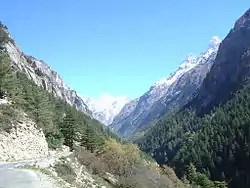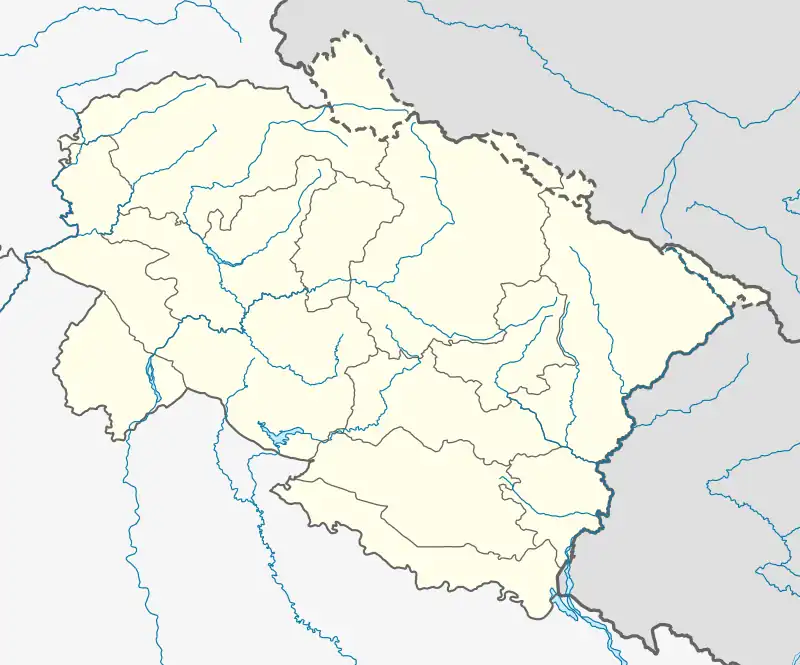Gangotri
| |
|---|---|
Town | |
 Gangotri | |
 Gangotri
Location in Uttarakhand, India  Gangotri
Gangotri
(India) | |
| Coordinates: 30°59′38″N 78°56′28″E / 30.994°N 78.941°E | |
| Country | |
| State | Uttarakhand |
| District | Uttarkashi |
| Elevation | 3,415 m (11,204 ft) |
| Population (2001) | |
| • Total | 606 |
| Languages | |
| • Official | Hindi |
| Time zone | UTC+5:30 (IST) |
| Vehicle registration | UK |
| Website | badrinath-kedarnath |
Gangotri is a town and a Nagar Panchayat (municipality) in Uttarkashi district in the state of Uttarakhand, India. It is 99 km from Uttarkashi, the main district headquarter. It is a Hindu pilgrim town on the banks of the river Bhagirathi – the origin of the river Ganges. The town is located on the Greater Himalayan Range, at a height of 3,100 metres (10,200 ft). According to a popular Hindu legend, the goddess Ganga descended here when Shiva released the mighty river from the locks of his hair.
.jpg.webp)
Gangotri significance
Gangotri is one of the four sites in the Chota Char Dham pilgrimage circuit. It is also the origin of the Ganges river and seat of the goddess Ganga. The river is called Bhagirathi at the source and acquires the name Ganga (the Ganges) from Devprayag onwards where it meets the Alaknanda. The origin of the holy river is at Gaumukh, set in the Gangotri Glacier, and is a 19 km trek from Gangotri. The original Gangotri Temple was built by the Nepalese general Amar Singh Thapa. The temple is closed from Diwali day every year and is reopened on Akshaya Tritiya.[1] During this time, the idol of the goddess is kept at Mukhba village, near Harsil. Ritual duties of the temple are supervised by the Semwal family of pujaris. These pujaris hail from Mukhba village.
 Gaumukh, source of the Ganges above Gangotri
Gaumukh, source of the Ganges above Gangotri Brahma Kamal Saussurea obvallata.[2]
Brahma Kamal Saussurea obvallata.[2]
Gangotri Temple
A temple dedicated to Goddess Ganga is located near a sacred stone where King Bhagiratha worshipped Shiva. According to Hindu texts, Ganga took the form of a river to absolve the sins of King Bhagiratha's predecessors, following his severe penance of several centuries. Bhagiratha Shila is a sacred slab where king Bhagiratha meditated. Ganga is believed to have touched earth at this spot. According to another legend, Pandavas performed the great 'Deva Yajna' here to atone the deaths of their kinsmen in the epic battle of the Mahabharata. Hindus believe that performing the ancestral rites on the banks of Bhagirathi frees the spirit of the ancestor from the cycle of rebirth and a holy dip in its waters cleanses sins committed in the present also past births.[3]
The Gangotri temple opens on the auspicious day of Akshaya Tritiya which falls in the month of May and closes on Yama Dvitiya or Bhai Dooj which falls in the month of November. The Gangotri temple remains closed for the rest of six months. The Goddess shifts to the village Mukhba during the winter months. In the month of May, Ganga Dussehra is celebrated with great fanfare as the day of the birth of Ganga.[4]
Demographics
According to the 2011 census of India, there are total 47 families residing in Gangotri. The total population of Gangotri is 110 out of which 97 are males and 13 are females. The literacy rate of Gangotri is 99.1%. The entire population of Gangotri identifies as Hindu.[5]
See also
References
- ↑ Gangotri Dham
- ↑ Brahma Kamal
- ↑ "Gangotri Dham – The Origin of River Ganges | RitiRiwaz". 4 December 2019. Retrieved 14 May 2022.
- ↑ Nanda (9 October 2018). "Gangotri Temple 2022 Opening Closing Dates – Gangotri Dham Important Dates". euttaranchal.com. Retrieved 19 June 2022.
- ↑ "Census: Population: Uttarakhand: Gangotri | Economic Indicators | CEIC". ceicdata.com. Retrieved 14 May 2022.
External links
- Official website
 Gangotri travel guide from Wikivoyage
Gangotri travel guide from Wikivoyage


